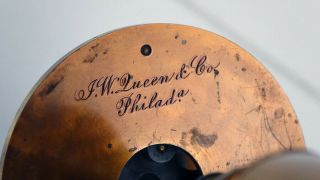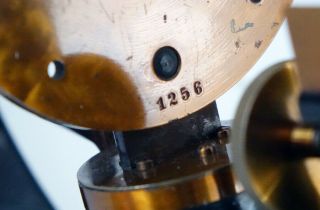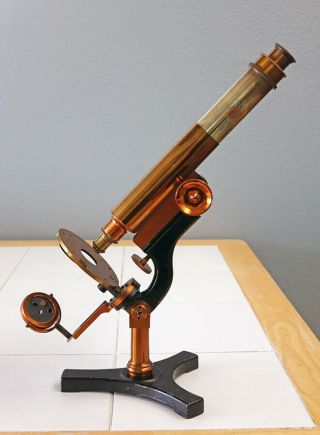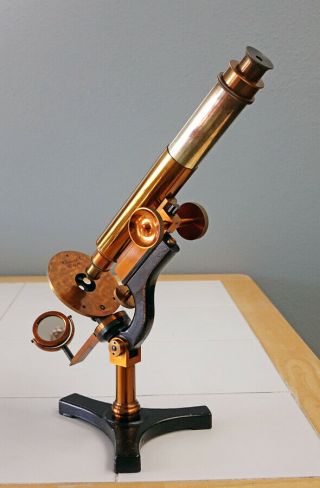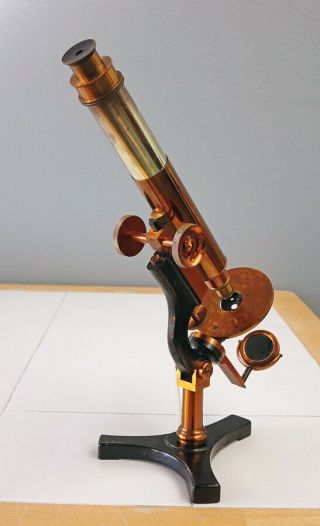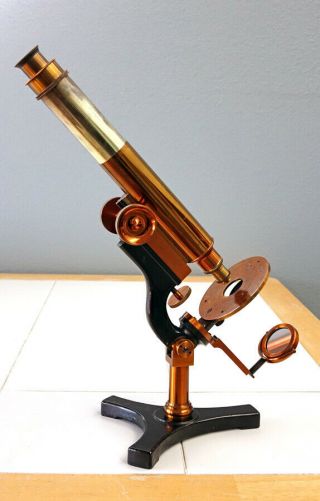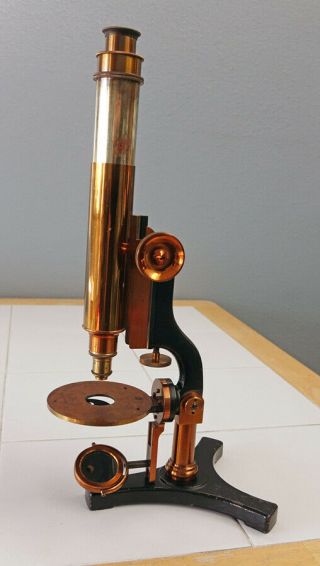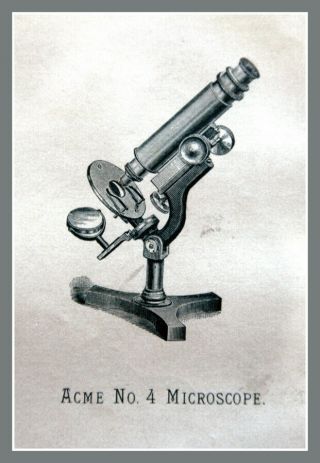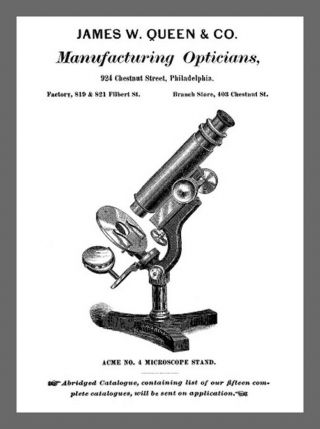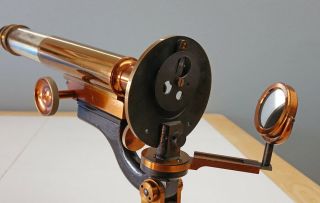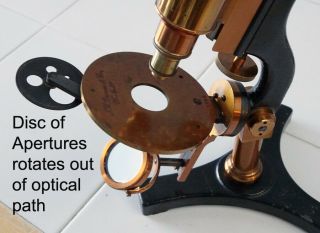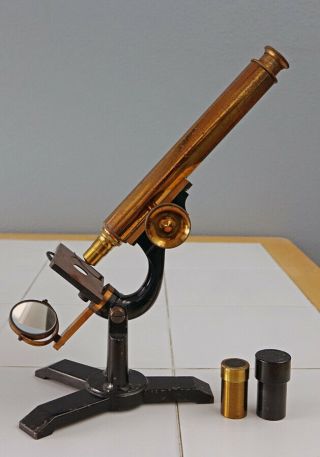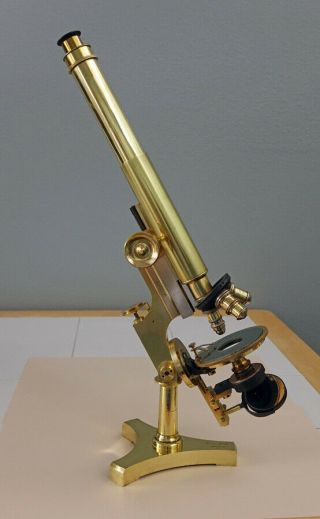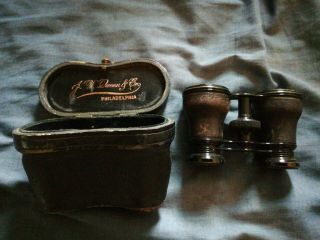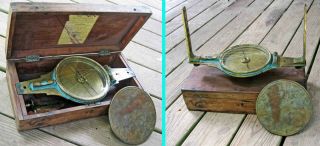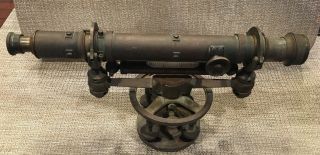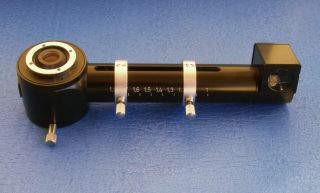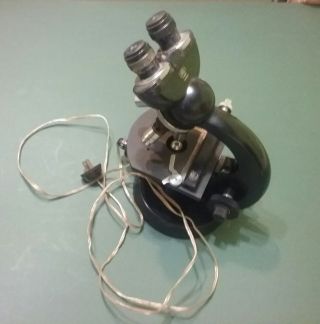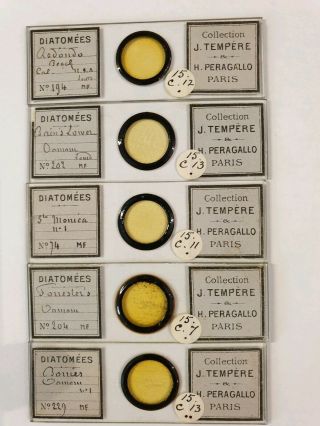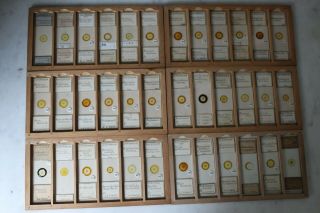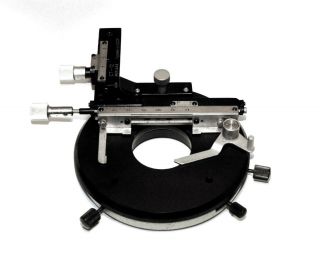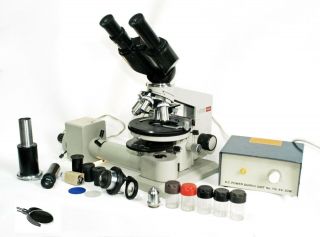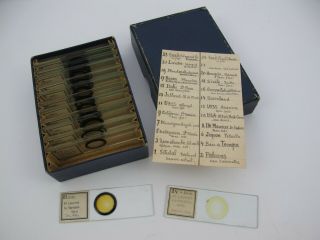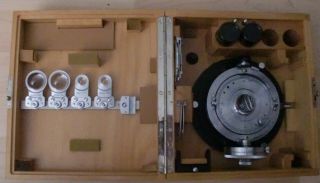JAS. W. QUEEN & CO ANTIQUE BRASS MICROSCOPE ACME NO. 4 STAND SN - 1256, CIRCA 1886
Item History & Price
J.W. QUEEN & CO ANTIQUE BRASS MICROSCOPE ACME NO. 4 STAND SN-1256 CIRCA 1886 (John W. Sidle, designer).
You are invited to purchase a relatively uncommon ant...ique lacquered brass microscope that was offered by James W. Queen & Co. of Philadelphia, PA. Offered here is a superbly preserved example of their Acme No. 4 Stand. This particular stand was designed by one of America’s premier microscope makers, John W. Sidle, and bears some of the unique recognizable features of that designer.
This instrument bears the name of the manufacturer in cursive script on the top front of the stage, “J.W. Queen & Co., Philad.a.” This instrument also bears the serial number “1256” found on the rear of the stage (Please see the accompanying images that show these inscriptions). This serial number dates this instrument to circa 1886.
NOTE: For more details on the history of the Acme microscope line initially designed by John W. Sidle and offered by James W. Queen & Co., please see below.
A full description of this model microscope along with an illustration appears in the “Pocket Catalogue of Microscopes, Magnifiers, Microscopical Accessories, Mounting Materials, etc.” published and copyrighted by James W. Queen & Co. in the year 1892. A copy of a cut of this model instrument from the catalogue is included with this listing for comparison with the instrument featured here. The exact similarities to the listed microscope are readily apparent. Also included with this listing is a copy of a typical period advertisement for this instrument that was published in many of the scientific journals of the day. In the aforementioned catalogue description, J. W. Queen & Co. especially recommended this model microscope for use by physicians and students in medicine and biology.
For the antique microscope collector – this pattern microscope model represents one of several significant advances in the evolution and design of the microscope pioneered by American microscope designers and manufacturers such as John W. Sidle and James W. Queen & Co. As such, it will be a most welcome addition to any antique microscope collection especially since it is an antique brass microscope model that is not often seen today.
DETAILED DESCRIPTION:
This microscope features a nicely sculpted black lacquered brass Y-shaped tripod foot that supports a single brass pillar that rises to a compass joint. The compass joint supports a very attractive sculpted curved limb of the microscope. The limb, in turn, supports the remainder of the microscope including the round stage and the body tube. The compass joint allows the microscope to be tilted at any angle from the vertical to allow for the comfortable viewing of specimen slides.
Mounted forward of the compass joint is a 90mm diameter round brass stage with very fancy scrollwork on its top surface. The stage has a 25mm central aperture. There is provision for a pair of slide clips atop the stage, but these are missing from this microscope.
Below the stage is a revolving disc of apertures. A unique feature to this disc of apertures is that it is so mounted on a brass bar so that it can be rotated completely out of the optical path (Please see the accompanying image that shows this feature). This allows an optional brass accessory sleeve (not included) to be screwed into the underside of the stage and within the threaded central aperture. This optional sleeve can be used to attach an optional Abbe condenser or polarization apparatus (not included).
Also below the stage is a 40mm diameter plano-concave mirror assembly mounted in brass, which is adjustable up or down on a mirror bar and also in an arc about the stage. The mirror bar is able to pivot about the stage on a compass joint, the axis of which lies in the plane of the stage, such that it can be adjusted to several angles below the stage for oblique illumination and even above the stage to provide incidental illumination to opaque objects (Note: Please see the accompanying composite image that shows the versatility of this arrangement). This is a simple modification of the Patented swinging substage mirror assembly first invented by the American Optician, Joseph Zentmayer in the year 1876. You may recall that Bausch & Lomb, Bulloch and others also used this swinging substage mirror system on several of their microscope models.
The body tube of this microscope is mounted within a dovetail sleeve. Coarse focus is by rack and pinion with horizontal rackwork (see image) and is controlled by a pair of oversize brass milled heads mounted at the back of the limb. The fine focus mechanism is found under the base of the limb rather than at the top of the limb. This is a definitive characteristic of microscopes designed by John W. Sidle and was also used by McIntosh and Tolles on their instruments. The fine focus is controlled by a single medium sized milled head.
The body tube of this microscope is equipped with an unmarked drawtube. At the top of the drawtube is a lacquered brass ocular holder. A single “top hat” style ocular is included with this instrument. In addition, this microscope comes with a single dual-part objective lens (unmarked). The lower element of this objective can be removed (unscrewed) in order to provide low power views. The provided optics combine to provide very satisfying high-resolution views of several antique prepared slides that I viewed using this instrument.
When the microscope stands vertical, the drawtube is nested into the body tube and the body tube is fully racked down to its lowest level, the microscope stands about 12 inches tall. When the body tube is fully racked out and the drawtube fully extended, it stands about 18 inches tall – making for a rather large and impressive instrument. The microscope weighs about 6 pounds. There is no wood case or any other accessories that come with this microscope.
STATEMENT OF CONDITION:
NOTE: The accompanying images are a part of this statement of condition. Please take the time to view all of the images so you can confirm the condition of the microscope and so you will know exactly what you will be getting should you prove to be the proud new owner of this fine James W. Queen & Co. Acme No. 4 Stand.
In summary, this microscope is in superb cosmetic, optical and mechanical condition making this instrument of near “museum quality.”
As can be ascertained from the accompanying images, the lacquered brass on this particular instrument is in excellent condition. With the exception of the top of the stage, which has a bit of tarnish and discoloration, along with a couple of minor tarnish spots on the body tube, the lacquer on the brass parts approaches 100% retention and reflects a very nice deep honey gold patina. The only action we have taken with this microscope is to clean it of dust with Windex and to give it a coating of Renaissance Wax to preserve its luster.
NOTE: WE MAKE IT A FIRM PRACTICE NOT TO DEEP CLEAN AND POLISH ANTIQUE BRASS MICROSCOPES.
The black lacquered foot has a couple of small spots where the lacquer has worn off, but it is otherwise in very good cosmetic condition.
The plano-concave mirror associated with this microscope is in very good condition and provides adequate illumination to the stage. The optics (eyepiece and objective lens) in this microscope are of high quality and are free of any optical defects. In combination, they produce sharp, high contrast images of prepared slides viewed with the instrument.
The mechanics including the coarse and fine focus mechanisms are working flawlessly. The disc of apertures also rotates freely and is able to be easily moved out of the optical path as one of the accompanying images shows. As is noted above, the slide clips are missing from the stage.
Overall, this is a nicely preserved example of a James W. Queen & Co. Acme No. 4 stand. This antique brass microscope from circa 1886 is most certainly worthy of any antique microscope collection. As an added bonus, despite its age of well over a century, this instrument still is fully functional and can still be used for serious microscopic investigations to this day – a nice tribute to both its designer and manufacturer and to the unknown former owner(s) who took really good care of this fine instrument.
ABOUT THE ACME MICROSCOPE MODEL MICROSCOPES AND JAMES W. QUEEN & CO.:
The Acme line of microscopes was first introduced into the American marketplace in 1879 by the optical firm of Sidle and Poalk of Philadelphia, PA. The very first microscope made by this firm was called, “The Acme, ” the name being derived from the Greek word “akme” meaning “the highest point.” By 1880, the firm had located to Lancaster, Pennsylvania at the corner of James and Cherry Streets and was doing business as John W. Sidle & Co. They called their factory “Acme Optical Works.”
In 1881, James W. Queen & Co., 924 Chestnut Street, Philadelphia, purveyors of a wide range of scientific and philosophical instruments, became business agents for John W. Sidle & Co. As a result of rapid early success in sales of his instruments, Sidle soon consigned to Queen & Co. the entire production of his facility in Lancaster. This resulted in a long and complex relationship between Sidle and Queen & Co. such that it appears that Sidle ultimately became an employee of Queen & Co. Subsequently, Sidle developed a complete line of Acme microscopes consisting of five models, which were numbered 2 through 6.
By the year 1886, Queen took over the production of the Acme line of microscopes and Sidle gradually slipped into the background as the inventor and designer of this instrument line. Queen then began to produce pictorial advertisements of the Acme line that appeared in all of the scientific journals of the day. Many of these early advertisements featured a medallion with the inscription, “Queen & Co. Microscope Makers, 924 Chestnut St., PHILA.” Later the advertisements boldly stated, “Makers of the Acme Microscopes” as they assumed full ownership of the brand name.
Acme microscopes were simple, durable and of relatively modest cost and received high praise from their users.
PURCHASE:
THE MONTANA LOGGER is very pleased to offer this James W. Queen & Co. Acme No. 4 Stand for a very reasonable Buy-It-Now price. We will also entertain reasonable offers for this antique brass microscope.
NOTE: WE WARMLY WELCOME INTERNATIONAL BIDDERS/BUYERS. WE SHIP WORLDWIDE.
PAYMENT: Payment via PayPal is due within 3 days of purchase. Prompt payment is always much appreciated. Thank you.
PaymentBack to Top
I accept the following forms of payment: PayPal
Shipping & HandlingBack to Top US Shipping$0.00 USPS Priority Mail®
International Shipping$97.00 USPS Priority Mail International (Worldwide)
$67.50 USPS Priority Mail International (Canada)
FREE scheduling, supersized images
and templates. Get Vendio Sales Manager.Make your listings stand out with
FREE Vendio custom templates!
FREE scheduling, supersized images
and templates. Get Vendio Sales Manager.
Over 100, 000, 000 served. Get FREE counters from Vendio today!




